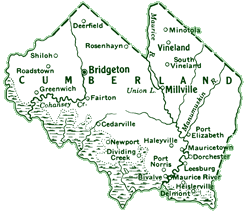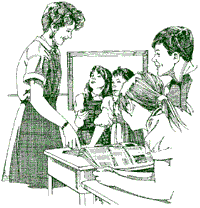 |
|
|||
Objectives Students will be able to:
County map State map Optional maps to use: Historical books, pamphlets, magazines Census materials Your county planning department may be able to provide GIS (Geographical Information System) and/or digital maps of your county. Making Connections The film Down Jersey focuses on life along the Delaware Bay Shore of Southern New Jersey, which includes portions of Cape May, Cumberland, and Salem counties. In order for students to truly gain a “sense of place,” it is imperative that they have an understanding of their place within this region. This activity, although written specifically for Cumberland County, can easily be adapted to both Cape May and Salem. It is this type of general overview of a county that will allow students to understand and appreciate the interactions among people and places. Investigating county histories, development, and demographics is an important tool in understanding our place within this system of government. Background The county is the political and geographic unit about which most students know the least. They travel extensively throughout places within the county yet are generally unclear about the direction in which they are going, the relative locations of the area, and the implications of human-environmental interactions within the county. This lesson plan allows the teacher to introduce or emphasize any one or all of the five geography themes, in a setting that is familiar and relevant to the student. It is adaptable to both elementary and secondary grades and to courses in American History, State History, Economics, Civics, Sociology, and Geography. In addition to the materials suggested here, it is also recommended that Chapter 2: “Urban Development” in the Blue Book (Historic Themes and Resources within the New Jersey Coastal Heritage Trail Route) also be read and utilized for discussions. This chapter contains many useful diagrams and maps that could easily be incorporated into this activity, especially in relation to the historical aspects of county development and growth. Procedure Warm Up Explain the purpose of the lesson and the objectives. Relate it to the film and to the students’ sense of place within the region. The Activity
a. Briefly review factual answers that focus on relative location. Discuss in depth students’ conclusions in terms of place and human-environmental interaction. Use land-use map if available. Examples: Vineland: largest city in New Jersey (area: 691/2 square miles) Bridgeton: smallest in county (61/2 square miles), county seat, park, zoo, river, loss of major industries (glass, food processing, clothing) and impact on employment Millville: arsenic in lake, use of Maurice River, Wheaton Village Maurice River: prison, Route 55, river, proposed toxic waste site, Wild & Scenic River designation, maritime history Commercial: oyster industry, sand mining, lake development PINE BARRENS, SANDY SOIL (GLASS INDUSTRY) Downe: sand mining, wetlands, wildlife areas WETLANDS, STATE CONTROL Lawrence: wetlands, farming, recreation, development FISHING, RECREATION
Greenwich: history, river, Pre-Civil War black community of Springtown, underground railroad, Swedish settlement, Quaker community, conflict over development as a “Williamsburg,” Bayside Tract (Nature Conservancy), Pre-historic Museum Stow Creek: causeway, Gum Tree Corner, river, wetlands Hopewell: shape, development, river, county home, detention center, cemetery (grave of first white settler), farming RICH SOIL AND FARMING/EMPLOYMENT Upper Deerfield: NJ Department of Agriculture, Rutgers Farm, Seabrook (tie to Japanese-American internment-museum; Estonian, Latvian and other cultures.) Deerfield: County/State facilities, farming Shiloh: size, location, 7th Day Adventist settlement b. Discuss the future of Cumberland County (or your county) in terms of human-environmental interactions and suggest solutions to potential problems (increased population, need for services, threat to farmland and wetlands vs. need for industry and employment). Discuss the need for proper planning, land and water management. Wrap Up Homework: Have students describe the route from school to home. They should include enough detail (perhaps even draw a map) including landmarks, physical features, as well as direction, so that they could be easily followed. The next day in class, have the students exchange directions, give each small group the map, and have each student try to find his/her way to the other student’s house. Assessment Students’ worksheets could serve as an assessment tool. In addition, an outline map of the county could be created and photocopied, students could be asked to “fill-in” as much information as they can recall on the map (i.e. major geographical features, towns, etc.). Extensions
Adaptation of Activity for Other Counties This activity can easily be adapted to be specific for any other county. This would require the teachers to develop a student map study worksheet for their particular county. Another option is to give teams of students a map and have each team develop a series of questions about the map. Teams could then trade “worksheets” (questions). This could be developed into a more meaningful experience for the students and be an actual contest/competition encouraging students to try to create difficult and “tricky” questions. For the complete lesson plan, please download the PDF file. Ticket to Vineland: The History and Culture of Vineland, New Jersey, An Activity Book for Third Grade Students Vineland Public Schools c/o Mrs. Jeanne Doremus |
|||

 Charting the Course
Charting the Course  Materials
Materials  Fairfield: river development, wildlife areas, Delaware Bay INDUSTRIAL DEVELOPMENT OF RIVERS
Fairfield: river development, wildlife areas, Delaware Bay INDUSTRIAL DEVELOPMENT OF RIVERS